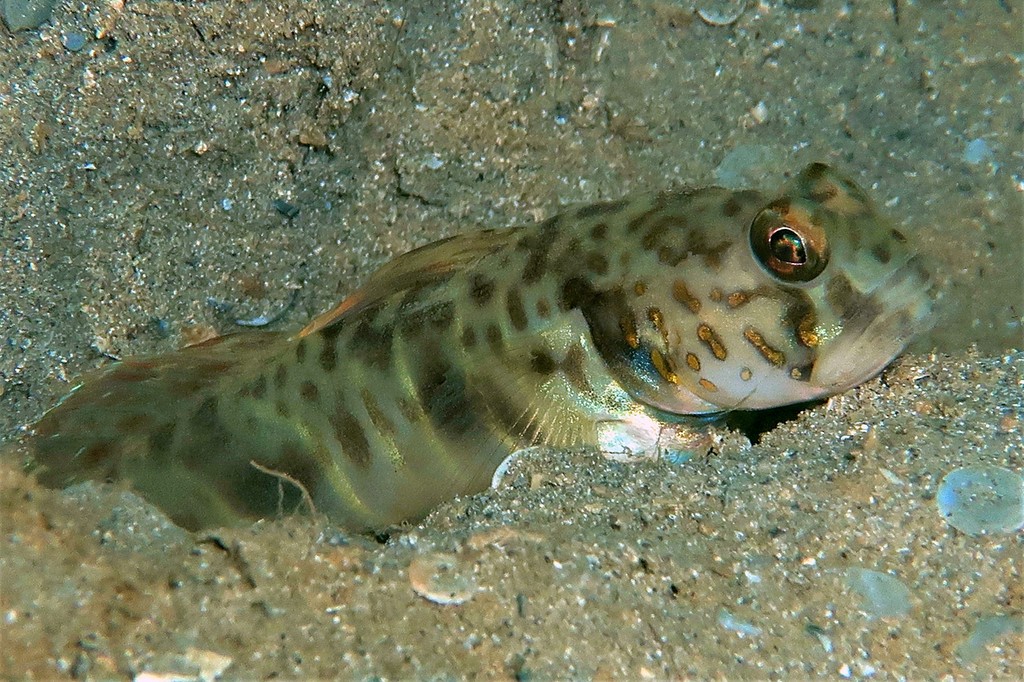TOMIYAMICHTHYS RUSSUS - (CANTOR, 1849)
Picture courtesy of: Alain Daoulas
Actinopterygii (Gigaclass) > Actinopteri (Class) > Teleostei (Subclass) > Gobiiformes (Order) > Gobioidei (Suborder) > Gobiidae (Family) > Gobiinae (Subfamily) > Tomiyamichthys (Genus)
Ocellated shrimpgoby, Ushioni-haze, ウシオニハゼ, 紅絲鰕虎魚,
Synonymes
Cryptocentrus polyophthalmus (Bleeker, 1853)
Cryptocentrus russus (Cantor, 1849)
Flabelligobius russus (Cantor, 1849)
Gobius polyophthalmus (Bleeker, 1853)
Gobius russus (Cantor, 1849)
Actinopterygii (Gigaclass) > Actinopteri (Class) > Teleostei (Subclass) > Gobiiformes (Order) > Gobioidei (Suborder) > Gobiidae (Family) > Gobiinae (Subfamily) > Tomiyamichthys (Genus)
Ocellated shrimpgoby, Ushioni-haze, ウシオニハゼ, 紅絲鰕虎魚,
Synonymes
Cryptocentrus polyophthalmus (Bleeker, 1853)
Cryptocentrus russus (Cantor, 1849)
Flabelligobius russus (Cantor, 1849)
Gobius polyophthalmus (Bleeker, 1853)
Gobius russus (Cantor, 1849)
---------------------------
Description
Dorsal spines (total): 6-7; Dorsal soft rays (total): 10; Anal spine: 1; Anal soft rays: 10; Pectoral fin rays: 18-20; Pelvic fin rays: I, 5; Caudal fin rays: 17; Gill rakers: 2-3 + 6-7; Longitudinal scale series: 77-97; Greatest depth of body: 5.1-6.1 in SL. Pelvic fins united, frenum present; Posterior body with ctenoid scales, becoming cycloid anteriorly; Scales absent from head; Caudal fin lanceolate, a little longer that head length; Oculoscapular sensory canal and pores present. Max. length: 12.0 cm TL. Depth range: 1 - 5 m.
Color
Greyish body with a dark bar below the eye, gold spots and a brown vertical patch on the gill cover, four large dark spots along the midside extending onto the back, and a large pale-edged spot on the rear margin of the first dorsal fin.
Etymology
Tomiyamichthys: in honor of ichthyologist (sometimes spelled Ichiro) Tomiyama (1906-1981), Tokyo Imperial University, who described type species, Tomiyamichthys oni, in 1936 + from Greek, ichthys = fish.
russus: from Latin, russus = red, reddish-brown. Referring to its “(f)lesh or pale salmon-colored” body.
Original description: Gobius russus Cantor, 1849 - Type locality: Sea of Penang, Malaysia.
Distribution
Western Pacific: Malaysia, Vietnam, Indonesia, Philippines, Papua New Guinea, New Caledonia and Yaeyama Islands (Japan).
Biology
Inhabits silty near shore reefs, often stream mouths. Ocellated shrimpgobies share burrows with alpheid shrimps.
Similar species
Tomiyamichthys levisquama (Hoese, Shibukawa & Johnson, 2016) - Reported from Northern Territory and Queensland, Australia.
Description
Dorsal spines (total): 6-7; Dorsal soft rays (total): 10; Anal spine: 1; Anal soft rays: 10; Pectoral fin rays: 18-20; Pelvic fin rays: I, 5; Caudal fin rays: 17; Gill rakers: 2-3 + 6-7; Longitudinal scale series: 77-97; Greatest depth of body: 5.1-6.1 in SL. Pelvic fins united, frenum present; Posterior body with ctenoid scales, becoming cycloid anteriorly; Scales absent from head; Caudal fin lanceolate, a little longer that head length; Oculoscapular sensory canal and pores present. Max. length: 12.0 cm TL. Depth range: 1 - 5 m.
Color
Greyish body with a dark bar below the eye, gold spots and a brown vertical patch on the gill cover, four large dark spots along the midside extending onto the back, and a large pale-edged spot on the rear margin of the first dorsal fin.
Etymology
Tomiyamichthys: in honor of ichthyologist (sometimes spelled Ichiro) Tomiyama (1906-1981), Tokyo Imperial University, who described type species, Tomiyamichthys oni, in 1936 + from Greek, ichthys = fish.
russus: from Latin, russus = red, reddish-brown. Referring to its “(f)lesh or pale salmon-colored” body.
Original description: Gobius russus Cantor, 1849 - Type locality: Sea of Penang, Malaysia.
Distribution
Western Pacific: Malaysia, Vietnam, Indonesia, Philippines, Papua New Guinea, New Caledonia and Yaeyama Islands (Japan).
Biology
Inhabits silty near shore reefs, often stream mouths. Ocellated shrimpgobies share burrows with alpheid shrimps.
Similar species
Tomiyamichthys levisquama (Hoese, Shibukawa & Johnson, 2016) - Reported from Northern Territory and Queensland, Australia.
Last update: 9, April 2023
